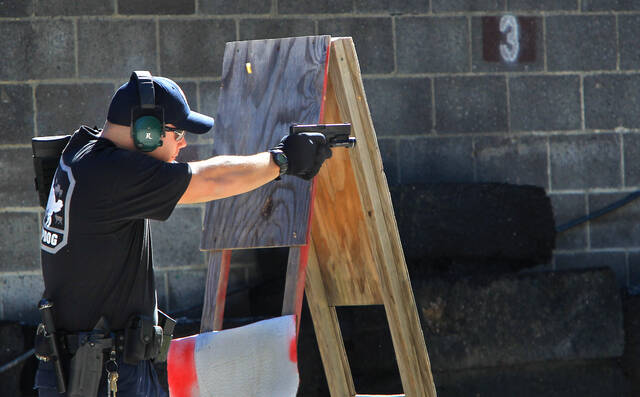
COLUMBUS, Ohio (AP) — School districts could set their own training requirements for armed employees under Republican legislation arising from a court battle over one district’s reaction to a school shooting.
The legislation pending in the GOP-controlled House Criminal Justice Committee would set a minimum of 20 hours of training on top of what’s needed to obtain a concealed weapons permit, but would allow districts to opt for more.
The bill is meant to override a state Supreme Court ruling earlier this year, which interpreted current Ohio law to require that armed teachers would need the same training as police, amounting to hundreds of hours. That would put the practice out of reach of almost all districts because of the time and expense.
At least 10 other states have laws allowing school personnel to be armed, including Texas, which expanded the practice in 2019 after a 2018 school shooting, and Florida, which also allowed districts to add more armed employees in 2019 following the Parkland massacre a year earlier.
WHAT LED TO THE DEBATE IN OHIO?
In February 2016, a 14-year-old boy opened fire on fellow students at a school cafeteria in southwestern Ohio. The teen pleaded guilty later that year to four attempted murder counts and one count of inducing panic. A judge ordered him held in juvenile detention until he turns 21, when he will be free if he stays out of trouble.
Two years later, the Madison Local School District board voted to allow teachers and staff who received 24 hours of one-time concealed weapons training to carry firearms. A group of parents then sued the district to prevent teachers from being armed without extensive training, equivalent to what a police officer undergoes.
WHAT DID THE COURTS SAY?
A Butler County judge dismissed the lawsuit, saying that school staffers did not need such training because they are not law enforcement officers.
The parents appealed to the 12th District Court of Appeals, which ruled that current Ohio law requires anyone who carries firearms in schools to have undergone a minimum of 728 hours of law enforcement training, the same as certified Ohio police officers.
The district appealed to the Ohio Supreme Court, which sided with the parents in June in a divided decision.
Nothing in Ohio law as it stands allows districts to circumvent the law’s training requirement, Chief Justice Maureen O’Connor wrote for the four-justice majority. The weapons training legislation was introduced by Rep. Thomas Hall, a Republican whose district includes Madison Local Schools, in response to the various court rulings.
WHAT DOES THE LEGISLATION DO?
Under the bill, armed school employees would need to take the eight hours of training required for a concealed weapons permit under Ohio law, then take 18 additional “general” hours of training and two hours of handgun training. The general training is defined only as instruction making an individual “qualified to serve as a person authorized to go armed within a school safety zone.” Employees would also have to complete two additional hours of general training and two hours of handgun training each year.
The current version of the bill lays out specific gun training goals that a prospective armed employee must meet, including, “take flanking step while drawing and fire two rounds into the preferred area of the torso and then one round into the head circle.”
WHO SUPPORTS THE BILL?
Nearly all submitted and in-person testimony opposes the measure. But the legislation has support from gun control groups such as the Buckeye Firearms Association, along with a handful of local law enforcement agencies and school districts.
One of those is Edgerton Local Schools in rural Williams County in northwestern Ohio, which in 2010 authorized a history teacher to go armed. The district of 600 students later trained a small group of armed volunteer staff members following the 2012 Sandy Hook massacre and the interruption of a 2013 school-shooting plot at Edgerton that included a plan to first shoot the high school’s lone armed teacher.
Edgerton’s armed staffers underwent nearly 60 hours of training and were required to receive an additional eight hours of annual training, both well above what the proposed legislation would mandate. The Supreme Court ruling ended the program and the district is now back to one armed teacher who is also a certified police officer.
Local school boards should be able to set training levels that meet their needs, said Edgerton superintendent Kermit Riehle, a bill supporter. For Edgerton, having armed employees is a priority, especially in a rural setting where a school shooting would likely be over before police could arrive, he said.
“This is the best scenario for us to protect our kids if and when that would ever happen — we pray that it never does,” Riehle said.
WHO OPPOSES THE MEASURE?
Multiple gun control groups including Moms Demand Action oppose the legislation, saying money is better spent on intervention programs for troubled youth and preventing students from getting access to guns in the first place.
Many police organizations also oppose the bill, including the Ohio Fraternal Order of Police, saying the training is inadequate and could create dangerous situations involving undertrained employees making split-second decisions as they confront armed individuals.
Veteran Columbus police officer Bob Meader told the House Justice Committee his story of responding to a non-emergency call in 1995 regarding a stolen license plate, only to come face to face with a young man holding a rifle. Meader was prepared to fire when the teen obeyed commands to drop the weapon.
“Would you want a school official with this scant training to make that same decision in that same moment?” said Meader, a police commander who said he was testifying on his and not the agency’s behalf. Meader said he advocates letting the state police training commission be in charge of setting rules for armed school employees.


